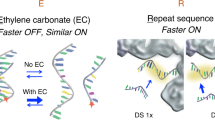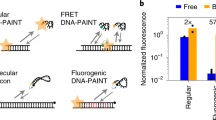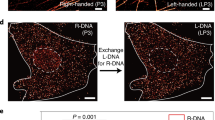Abstract
DNA points accumulation in nanoscale topography (DNA-PAINT) is a relatively easy-to-implement super-resolution technique. However, image acquisition is slow compared to most other approaches. Here, we overcome this limitation by designing optimized DNA sequences and buffer conditions. We demonstrate our approach in vitro with DNA origami and in situ using cell samples, and achieve an order of magnitude faster imaging speeds without compromising image quality or spatial resolution. This improvement now makes DNA-PAINT applicable to high-throughput studies.
This is a preview of subscription content, access via your institution
Access options
Access Nature and 54 other Nature Portfolio journals
Get Nature+, our best-value online-access subscription
9,800 Yen / 30 days
cancel any time
Subscription info for Japanese customers
We have a dedicated website for our Japanese customers. Please go to natureasia.com to subscribe to this journal.
Buy this article
- Purchase on SpringerLink
- Instant access to full article PDF
Prices may be subject to local taxes which are calculated during checkout



Similar content being viewed by others
Data availability
All raw data is available upon reasonable request from the authors.
References
Sahl, S. J., Hell, S. W. & Jakobs, S. Nat. Rev. Mol. Cell Biol. 18, 685–701 (2017).
Schnitzbauer, J., Strauss, M. T., Schlichthaerle, T., Schueder, F. & Jungmann, R. Nat. Protoc. 12, 1198–1228 (2017).
Dai, M., Jungmann, R. & Yin, P. Nat. Nanotechnol. 11, 798–807 (2016).
Strauss, S. et al. Nat. Methods 15, 685–688 (2018).
Auer, A., Strauss, M. T., Schlichthaerle, T. & Jungmann, R. Nano Lett. 17, 6428–6434 (2017).
Lee, J., Park, S. & Hohng, S. Mol. Brain 11, 70 (2018).
Jungmann, R. et al. Nat. Methods 13, 439–442 (2016).
Jayasinghe, I. et al. Cell Rep. 22, 557–567 (2018).
Stehr, F., Stein, J., Schueder, F., Schwille, P. & Jungmann, R. Nat. Commun. 10, 1268 (2019).
Ouldridge, T. E., Sulc, P., Romano, F., Doye, J. P. & Louis, A. A. Nucleic Acids Res 41, 8886–8895 (2013).
Cisse, I. I., Kim, H. & Ha, T. Nat. Struct. Mol. Biol. 19, 623–627 (2012).
He, G., Li, J., Ci, H., Qi, C. & Guo, X. Angew. Chem. Int Ed. Engl. 55, 9036–9040 (2016).
Schickinger, M., Zacharias, M. & Dietz, H. Proc. Natl. Acad. Sci. USA 115, E7512–E7521 (2018).
Zhang, J. X. et al. Nat. Chem. 10, 91–98 (2018).
Zadeh, J. N. et al. J. Comput Chem. 32, 170–173 (2011).
Tokunaga, M., Imamoto, N. & Sakata-Sogawa, K. Nat. Methods 5, 159–161 (2008).
Endesfelder, U., Malkusch, S., Fricke, F. & Heilemann, M. Histochem Cell Biol. 141, 629–638 (2014).
Edelstein, A. D. et al. J. Biol. Methods 1, pii: e10. (2014).
Vaughan, J. C., Jia, S. & Zhuang, X. Nat. Methods 9, 1181–1184 (2012).
Lee, J., Park, S., Kang, W. & Hohng, S. Mol. Brain 10, 63 (2017).
Schueder, F. et al. Nat. Commun. 8, 2090 (2017).
Legant, W. R. et al. Nat. Methods 13, 359–365 (2016).
Beghin, A. et al. Nat. Methods 14, 1184–1190 (2017).
Aitken, C. E., Marshall, R. A. & Puglisi, J. D. Biophysical J. 94, 1826–1835 (2008).
Agasti, S. S. et al. Chem. Sci. 8, 3080–3091 (2017).
Acknowledgements
We thank J. Bauer and P. Schueler for initial experiments. We thank J. Lara-Gutiérrez and G. Cardone for fruitful discussions. This work has been supported in part by the German Research Foundation through the Emmy Noether Program (no. DFG JU 2957/1-1), the SFB1032 (project no. A11), the European Research Council through an ERC Starting Grant (MolMap; grant agreement no. 680241), the Allen Distinguished Investigator Program through the Paul G. Allen Frontiers Group, the Max Planck Foundation and the Max Planck Society. J.S., F.Stehr and A.A. acknowledge support by the QBM graduate school. M.T.S. acknowledges support from the International Max Planck Research School for Molecular and Cellular Life Sciences.
Author information
Authors and Affiliations
Contributions
F.Schueder conceived and performed experiments, analyzed data and contributed to the writing of the manuscript. J.S. and F.Stehr developed instrumentation. A.A. developed instrumentation and analyzed data. B.S. developed labeling reagents. M.T.S. developed software. P.S. supervised part of the study. R.J. conceived and supervised the study, interpreted data and wrote the manuscript. All authors reviewed and approved the manuscript.
Corresponding author
Ethics declarations
Competing interests
The authors declare no competing interests.
Additional information
Peer review information Rita Strack was the primary editor on this article and managed its editorial process and peer review in collaboration with the rest of the editorial team.
Publisher’s note Springer Nature remains neutral with regard to jurisdictional claims in published maps and institutional affiliations.
Integrated supplementary information
Supplementary Figure 1
Dark and bright time distributions (values indicate mean and standard deviation) for PS3 and P1 at 10 and 75 mM MgCl2 (P1 10 mM MgCl2 N=437, P1 75 mM MgCl2 N = 685, PS3 10 mM MgCl2 N = 473, PS3 75 mM MgCl2 N = 224). Each experiment was repeated three times independently.
Supplementary Figure 2 Repeats for P1 and PS3.
Comparison of dark times (values indicating mean and standard deviation) for P1 at 10 mM MgCl2 concentration and PS3 at 75 mM Magnesium concentration for three independent repeated experiments. Average dark time for P1 at 10 mM is τD=37.68 s and for PS3 at 75 mM τD=3.84 s (P1 10 mM MgCl2: N = 3010, N = 2123, N = 1585 (top to bottom); PS3 75 mM MgCl2: N = 506, N = 693, N = 293 (top to bottom)).
Supplementary Figure 3 Sequence analysis for P1 and PS3.
While the classical P1 DNA-PAINT sequence has potential self-interactions, the PS3 sequence as exemplary speed-optimized DNA-PAINT sequence shows no self-interactions for handle and imager sequence in Nupack (Zadeh, J.N. et al. NUPACK: Analysis and design of nucleic acid systems. J Comput Chem 32, 170–173 (2011).) pair probability diagrams (position, color, and size of squares represent pair probabilities where color and size scale with the interaction probability). (a) Calculations for P1 imager and docking sequence performed with 50 mM NaCl and 10 mM MgCl2 at 23 °C. (b) Calculations for PS3 imager and docking sequence performed with 50 mM NaCl and 75 mM MgCl2 at 23 °C.
Supplementary Figure 4 Kinetic comparison of PS1 to PS4 with P1.
All PS sequences show a significantly shorter τD compared to the classical P1 DNA-PAINT sequence (P1: N = 1032, PS1: N = 613, PS2: N = 187, PS3: N = 357, PS4: N = 689). Mean values for τD and τB for all distributions can be found in Supplementary Table 1.
Supplementary Figure 5 Kinetic comparison of PS5 to PS8 with P1.
All PS sequences show a scientifically shorter τD compared to the classical P1 DNA-PAINT sequence (P1: N = 1032, PS5: N = 841, PS6: N = 347, PS7: N = 1511, PS8: N =960). Mean values for τD and τB for all distributions can be found in Supplementary Table 1.
Supplementary Figure 6
Dark and bright time distributions (values indicate mean and standard deviation) for PS1—PS8 at 10 mM Magnesium concentration (PS1: N = 613, PS2: N = 187, PS3: N = 357, PS4: N = 689, PS5: N = 841, PS6: N = 347, PS7: N = 1511, PS8: N =960). Each experiment was repeated three times independently.
Supplementary Figure 7 Magnesium concentration series for P1 and PS3.
By increasing the buffer salinity, τB increases and τD decreases. This trend is clearly visible for both (P1 and PS3) magnesium concentration series (P1 10 mM MgCl2: N = 437, P1 25 mM MgCl2: N = 772, P1 50 mM MgCl2: N = 490, P1 75 mM MgCl2: N = 685, PS3 10 mM MgCl2: N = 473, PS3 25 mM MgCl2: N = 146, PS3 50 mM MgCl2: N = 260, PS3 75 mM MgCl2: N = 224). Mean values for τD and τB for all distributions can be found in Supplementary Table 1.
Supplementary Figure 8
Dark and bright time distributions (values indicate mean and standard deviation) for P1 and PS3 at 10, 25, 50, and 75 mM MgCl2 (P1 10 mM MgCl2: N = 437, P1 25 mM MgCl2: N = 772, P1 50 mM MgCl2: N = 490, P1 75 mM MgCl2: N = 685, PS3 10 mM MgCl2: N = 473, PS3 25 mM MgCl2: N = 146, PS3 50 mM MgCl2: N = 260, PS3 75 mM MgCl2: N = 224). Each experiment was repeated three times independently.
Supplementary Figure 9 DNA origami designs for in vitro experiments.
(a) 1× docking site and 2× docking site DNA origami (used for Data in Fig. 1a, d, Supplementary Fig. 1, 2, 4-8 and 10). For the 1× docking site only the red position was extended for the 2× docking site structure the red and the green position were extended. A detailed DNA staple list can be found in Supplementary Data 2. (b) 20-nm-grid DNA origami structure design. A detailed DNA staple list can be found in Supplementary Data 3, 6. (c) Speed logo (5 nm) DNA origami structure design. A detailed DNA staple list can be found in Supplementary Data 4. (d) 10-nm-grid DNA origami structure design. A detailed DNA staple list can be found in Supplementary Data 5.
Supplementary Figure 10 Comparison of Cy3b- and Atto643-labeled oligos.
(a) Dark time distributions alongside mean and standard deviation for Cy3b-labeled imager strands for P1 and PS3 at 10 and 75 mM MgCl2, respectively. (P1 10mM N = 437, P1 75 mM N = 685, PS3 10mM N = 473, PS3 75 mM N = 224) (b) Dark time distributions alongside mean and standard deviation for Atto643-labeled imager strands for P1 and PS3 at 10 and 75 mM MgCl2, respectively. (P1 10mM N = 694, P1 75 mM N = 1578, PS3 10mM N = 1048, PS3 75 mM N = 4709) (c) Time evolution of a single 20-nm-grid structure for Cy3b-labeled PS3 in 1xTE Buffer with 75 mM MgCl2. (d) Time evolution of a single 20-nm-grid structure for Atto643-labeled PS3 in 1xTE Buffer with 75 mM MgCl2. Scale bar: 20 nm.
Supplementary Figure 11 Whole field of view of Golgi experiment with PS3 @ 75 mM MgCl2. This experiment was repeated three times independently.
Imager concentration 0.5 nM. Scale bar: 5 µm.
Supplementary Figure 12 Whole field of view of Golgi experiment with P1 @ 10 mM MgCl2. This experiment was repeated three times independently.
Imager concentration: 5 nM. Scale bar: 5 µm.
Supplementary Figure 13 Time evolution of speed-optimized microtubule imaging.
Top panel shows an overview image of a microtubule network in fixed cells after 150 s. Bottom panels depict a zoom-in (highlighted in the overview image) after 10, 20, 30, 60, 100 and 150 s imaging time, respectively. The histograms present a cross-sectional histogram analysis of the highlighted area in the zoom-ins. After ~30 s of imaging with speed-optimized DNA-PAINT the ‘hollowness’ of the microtubules can be visualized. Localization precision (Endesfelder, U., Malkusch, S., Fricke, F. & Heilemann, M. A simple method to estimate the average localization precision of a single-molecule localization microscopy experiment. Histochem Cell Biol 141, 629–638 (2014).): ~8 nm. Achievable spatial resolution: ~19 nm. We note that this high spatiotemporal resolution is currently not achievable with approaches such as FRET-PAINT. This experiment was repeated three times independently. Scale bars: 5 µm (overview), 2 µm (zoom-ins).
Supplementary information
Supplementary Information
Supplementary Figs. 1–13 and Tables 1–5.
Supplementary Spreadsheet 1
Scaffold strand sequence.
Supplementary Spreadsheet 2
Staple strands for DNA origami.
Supplementary Spreadsheet 3
Staple strands for DNA origami.
Supplementary Spreadsheet 4
Staple strands for DNA origami.
Supplementary Spreadsheet 5
Staple strands for DNA origami.
Supplementary Video 1
Video recording of interactive speed-optimized 1 mm2 DNA-PAINT micrograph (http://speedpaint.jungmannlab.org) of the microtubule network in fixed HeLa cells.
Rights and permissions
About this article
Cite this article
Schueder, F., Stein, J., Stehr, F. et al. An order of magnitude faster DNA-PAINT imaging by optimized sequence design and buffer conditions. Nat Methods 16, 1101–1104 (2019). https://doi.org/10.1038/s41592-019-0584-7
Received:
Accepted:
Published:
Issue Date:
DOI: https://doi.org/10.1038/s41592-019-0584-7
This article is cited by
-
Multicolor single-molecule localization microscopy: review and prospect
PhotoniX (2024)
-
Quantification of absolute labeling efficiency at the single-protein level
Nature Methods (2024)
-
The DNA-PAINT palette: a comprehensive performance analysis of fluorescent dyes
Nature Methods (2024)
-
Combining pMINFLUX, graphene energy transfer and DNA-PAINT for nanometer precise 3D super-resolution microscopy
Light: Science & Applications (2023)
-
Dual-color DNA-PAINT single-particle tracking enables extended studies of membrane protein interactions
Nature Communications (2023)



